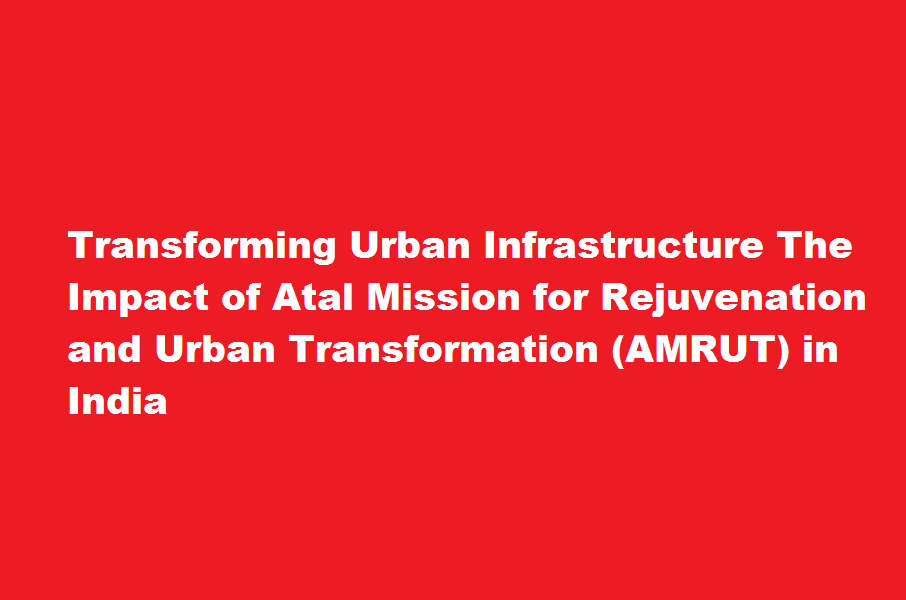Transforming Urban Infrastructure The Impact of Atal Mission for Rejuvenation and Urban Transformation (AMRUT) in India
4 min read
Introduction
India’s rapid urbanization has presented significant challenges in terms of infrastructure development, service delivery, and the overall quality of life in cities. Recognizing the need for holistic urban planning and sustainable urban growth, the Government of India launched the Atal Mission for Rejuvenation and Urban Transformation (AMRUT). This ambitious mission aims to provide basic urban amenities, improve infrastructure, and enhance the quality of life for residents in urban areas across the country. In this article, we will delve into the transformative impact of AMRUT in the development of urban infrastructure in India.
Provision of Basic Services
AMRUT focuses on providing basic services like water supply, sewerage, sanitation, stormwater drainage, and urban transport to improve the quality of life for urban dwellers. The mission emphasizes the provision of piped water supply, ensuring access to clean drinking water for all residents. Additionally, it aims to improve sanitation facilities, reduce open defecation, and enhance waste management systems in urban areas.
Sustainable Urban Planning
AMRUT emphasizes sustainable urban planning and development by integrating smart solutions, green technologies, and environment-friendly practices. The mission promotes the adoption of energy-efficient systems, renewable energy sources, and waste management techniques to create sustainable and environmentally conscious cities. This approach ensures long-term resilience and reduces the carbon footprint of urban areas.
Infrastructure Development
AMRUT has significantly contributed to infrastructure development in Indian cities. It focuses on the creation of robust urban infrastructure, including roads, bridges, public parks, playgrounds, and community centers. The mission also supports the development of affordable housing, ensuring access to quality housing for urban residents, particularly the economically weaker sections.
Urban Mobility and Transport
AMRUT recognizes the importance of efficient urban mobility and transport systems. The mission aims to improve public transportation, promote non-motorized transport like cycling and pedestrian walkways, and develop last-mile connectivity solutions. These initiatives reduce traffic congestion, improve air quality, and enhance the overall mobility experience for urban residents.
Capacity Building and Institutional Reforms
AMRUT focuses on capacity building and institutional reforms to strengthen urban governance and improve service delivery. The mission emphasizes the development of skilled human resources, institutional frameworks, and robust systems for urban planning, management, and administration. These efforts enable cities to effectively implement and sustain urban development initiatives.
Citizen Engagement and Participation
AMRUT emphasizes citizen engagement and participation in urban planning and decision-making processes. The mission encourages the formation of citizen-centric forums, such as Resident Welfare Associations (RWAs) and Citizens’ Advisory Committees, to ensure the active involvement of residents in shaping their cities. This participatory approach fosters a sense of ownership and empowers citizens to contribute to the development and maintenance of urban infrastructure.
Conclusion
The Atal Mission for Rejuvenation and Urban Transformation (AMRUT) has been instrumental in revolutionizing urban infrastructure development in India. Through its focus on providing basic services, sustainable urban planning, infrastructure development, improved mobility, capacity building, and citizen participation, AMRUT has enhanced the livability and quality of life in Indian cities. As the mission continues to drive urban transformation, it is crucial to sustain and strengthen these initiatives, fostering inclusive, resilient, and sustainable cities for future generations.
Frequently Asked Questions
What is the Atal Mission for Rejuvenation and Urban Transformation (AMRUT)?
The Atal Mission for Rejuvenation and Urban Transformation (AMRUT) is a government initiative in India aimed at transforming urban infrastructure and improving the quality of life in urban areas by providing basic services, promoting sustainable urban planning, and enhancing infrastructure development.
How does AMRUT contribute to the development of urban infrastructure in India?
AMRUT contributes to the development of urban infrastructure in India by providing basic services like water supply, sanitation, and urban transport, focusing on sustainable urban planning, promoting infrastructure development, improving urban mobility and transport, and fostering citizen engagement and participation.
What are the key features of AMRUT?
The key features of AMRUT include the provision of basic services, sustainable urban planning, infrastructure development, improving urban mobility and transport, capacity building and institutional reforms, and citizen engagement and participation.
How does AMRUT promote sustainable urban development?
AMRUT promotes sustainable urban development by integrating smart solutions, green technologies, and environment-friendly practices, promoting energy-efficient systems and renewable energy sources, and emphasizing waste management and environmental conservation in urban areas.
How does AMRUT involve citizens in urban planning and development?
AMRUT involves citizens in urban planning and development by encouraging citizen engagement and participation through the formation of citizen-centric forums, such as Resident Welfare Associations (RWAs) and Citizens’ Advisory Committees, ensuring their active involvement in decision-making processes and shaping the development of their cities.
Read Also : Empowering Women and Marginalized Communities






